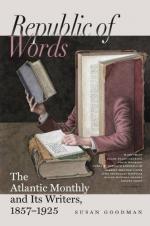But we must not omit one of the most important exercises for children in the Kindergarten,—that of block-building. Froebel has four Gifts of blocks. Ronge’s “Kindergarten Guide” has pages of royal octavo filled with engraved forms that can be made by variously laying eight little cubes and sixteen little planes two inches long, one inch broad, and one-half an inch thick. Chairs, tables, stables, sofas, garden-seats, and innumerable forms of symmetry, make an immense resource for children, who also should be led to invent other forms and imitate other objects. So quick are the fancies of children, that the blocks will serve also as symbols of everything in Nature and imagination. We have seen an ingenious teacher assemble a class of children around her large table, to each of whom she had given the blocks. The first thing was to count them, a great process of arithmetic to most of them. Then she made something and explained it. It was perhaps a light-house,—and some blocks would represent rocks near it to be avoided, and ships sailing in the ocean; or perhaps it was a hen-coop, with chickens inside, and a fox prowling about outside, and a boy who was going to catch the fox and save the fowls. Then she told each child to make something, and when it was done hold up a hand. The first one she asked to explain, and then went round the class. If one began to speak before another had ended, she would hold up her finger and say,—“It is not your turn.” In the course of the winter, she taught, over these blocks, a great deal about the habits of animals. She studied natural history in order to be perfectly accurate in her symbolic representation of the habitation of each animal, and their enemies were also represented by blocks. The children imitated these; and when they drew upon their imaginations for facts, and made fantastic creations, she would say,—“Those, I think, were Fairy hens” (or whatever); for it was her principle to accept everything, and thus tempt out their invention. The great value of this exercise is to get them into the habit of representing something they have thought by an outward symbol. The explanations they are always eager to give teach them to express themselves in words. Full scope is given to invention, whether in the direction of possibilities or of the impossibilities in which children’s imaginations revel,—in either case the child being trained to the habit of embodiment of its thought.
Froebel thought it very desirable to have a garden where the children could cultivate flowers. He had one which he divided into lots for the several children, reserving a portion for his own share in which they could assist him. He thought it the happiest mode of calling their attention to the invisible God, whose power must be waited upon, after the conditions for growth are carefully arranged according to laws which they were to observe. Where a garden is impossible, a flowerpot with a plant in it for each child to take care of would do very well.




